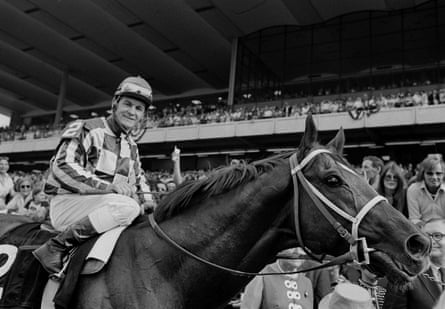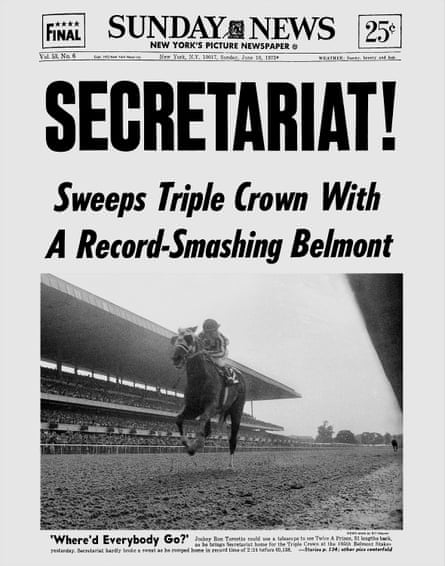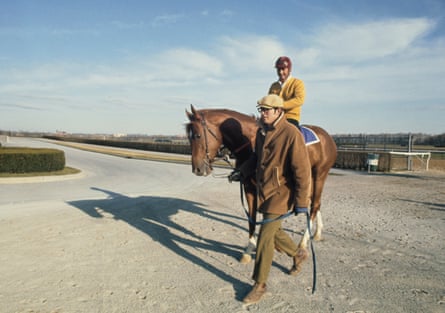WORD NEWS
Secretariat at 50: America’s equine hero endures within the nationwide lore | Horse racing
Even in 2023, the identify Secretariat is recognizable to hundreds of thousands of Individuals in any other case unversed in horse racing. Tributes to probably the most well-known racehorse of the Seventies are in every single place. Greater than 250 streets within the US are named after Secretariat (greater than any human athlete), he was considered one of ESPN’s prime 50 North American athletes of the twentieth century, and, considerably confusingly, he even served because the foundation for a personality in Netflix’s hit animated sitcom BoJack Horseman.
This weekend’s Kentucky Derby marks the fiftieth anniversary of Secretariat’s victory at Churchill Downs, which was itself step one within the horse’s signature achievement – profitable the 1973 Triple Crown.
“It’s exhausting to overlook,” Ron Turcotte, the Corridor of Fame jockey who rode Secretariat to victory in every of his Triple Crown races, tells the Guardian. “[Secretariat’s] identify comes up so typically that it don’t seem to be it’s been that lengthy … he’s in every single place on YouTube. Each time I really feel like him, I can see him there.”
Secretariat’s greatness is sometimes decreased to mechanical phrases, the implication being that his accomplishments had been purely a product of his distinctive bodily attributes.
It’s due to this fact exceptional that, for probably the most half, Turcotte speaks of Secretariat’s character when describing what made him such an awesome horse. “He was a really clever horse,” Turcotte says. “By no means appeared to struggle the rider – by no means fought me anyway – and he would calm down … You can make as many [tactical] strikes as you needed to in a race.”
Certainly, one of many few occasions Turcotte mentions Secretariat’s physicality is in reference to the horse’s prodigious urge for food. Even then, Turcotte speaks with the gently shocked fondness of a grandparent ribbing a very ravenous grandchild. “He was a heavy horse – by that I imply he ate loads,” says Turcotte. “He ate 18 quarts of oats a day.” For comparability, the common racehorse eats a each day ration of 12 to 14 quarts of oats.
Talking with Turcotte, it turns into rapidly evident that, on the age of 81, his reminiscence surrounding his horse racing profession borders on the photographic. He remembers coaching classes simply in addition to high-profile races. Turcotte particularly mentions one prematurely deserted exercise with Secretariat within the days earlier than the Wooden Memorial, the final race the pair would run in preparation for the 1973 Kentucky Derby. “I [worked] him a gradual mile. I used to be speculated to go sooner, however the horse that was in entrance of me threw his rider and the horse was zigzagging in entrance of me. I didn’t wish to take any possibilities and have [the other horse] minimize in entrance of me, so I didn’t let him work quick that morning.”
In what was thought of an upset on the time, Secretariat positioned third within the Wooden Memorial later that week (after profitable each earlier race that 12 months). Issues emerged about his skill to run the longer distances required in races just like the Kentucky Derby. These issues would show unfounded.

The Kentucky Derby is a one-and-a-quarter-mile flat race over a dust monitor. An vital race in its personal proper, the Derby concurrently serves as the primary jewel within the Triple Crown, a trio of high-prestige races that additionally contains the Preakness Stakes (held two weeks after the Derby) and the Belmont Stakes (run three weeks after the Preakness). The Derby, nonetheless, stays probably the most well-known of the three, in addition to the race more than likely to draw an informal fan’s consideration.
In contrast to the UK’s Grand Nationwide, horses solely get one shot on the Triple Crown of their lifetimes – the Derby, the Preakness and the Belmont are all restricted to three-year-old horses. The rationale behind this restriction has been misplaced to historical past, but it surely’s typically believed that it makes for extra thrilling, unpredictable racing. Two-year-old horses are nonetheless thought of juveniles, whereas elite four-year-old horses have already developed into well-known entities. Consequently, three-year-old racing represents the interesting mixture of athletically mature horses who might nonetheless shock punters.
Twelve horses have gained the Triple Crown during the last century. However, there’s all the time been one thing completely different about Secretariat’s 1973 win. Amongst different distinctions, Secretariat was the primary horse to win the Triple Crown in 25 years, at the moment by far the longest hole between Triple Crown winners. The Seventies additionally marked the tail finish of horse racing’s peak reputation, making Secretariat one of many sport’s last superstars earlier than it transitioned into its present-day thriving, however a lot smaller, cultural area of interest. Greater than any of those related (however secondary) causes, nonetheless, Secretariat’s Triple Crown win stays distinctive as a result of it’s objectively higher than that of another horse within the historical past of the competitors.
In the course of the Triple Crown’s first leg, Secretariat set the monitor report on the Kentucky Derby, changing into the primary horse to complete the race in underneath two minutes (together with Sham, who got here in two and a half lengths behind in second). Earlier doubts about Secretariat’s endurance had been made to look foolish – he ran every quarter-mile of the race sooner than the earlier quarter-mile (he ran the ultimate quarter over two seconds sooner than the primary). He then broke the monitor report on the Preakness earlier than, three weeks later, delivering maybe his most well-known efficiency on the Belmont. Not solely did Secretariat set one more monitor report – he gained the Belmont by a exceptional 31 lengths (roughly 75 meters). Fifty years later, Secretariat’s win on the Belmont stays the biggest margin of victory in Triple Crown historical past. Furthermore, 50 years later, all three of Secretariat’s monitor data stay unbeaten.
Turcotte provides a easy rationalization for the data’ longevity: “There was just one Secretariat.” However so too was there just one Ron Turcotte. Sure, Turcotte was lucky to journey an animal athlete as magnificent as Secretariat, however Secretariat was additionally fortunate to be jockeyed by a sportsman as gifted as Turcotte.
It’s a query that comes up typically when outsiders talk about horse racing – how a lot credit score for a win ought to go to the horse and the rider, respectively? Turcotte is characteristically humble when discussing his contributions to Secretariat’s success, reckoning that the horse ought to obtain about 90% of the reward. “I’ve by no means seen a jockey come throughout the wire with a horse on his again. The horse is the one which wins the race.”
That could be true, however Turcotte seems to be promoting himself quick. Only one 12 months earlier than Secretariat’s Triple Crown sweep, for instance, Turcotte rode a special horse (Riva Ridge) to wins in two of the three Triple Crown races. Regardless of his repeated successes on the sport’s highest ranges, nonetheless, Turcotte didn’t seem destined to be a jockey in his youth.

Rising up in a rural, French-Canadian family in New Brunswick, Turcotte left highschool earlier than graduating to affix his father within the timber trade which, importantly, nonetheless relied on horses to tug fallen bushes within the Fifties. “I labored within the lumber for 5 years,” Turcotte says. “That’s the place I discovered my horsemanship – my dad taught me about it. I used to be in love with horses from the time I can bear in mind.”
Turcotte offers two causes for leaving lumberjacking after 5 years. First, “they had been popping out with machines to haul wooden as a substitute of horses,” and the horses had been his favourite a part of the work. And second, “My brother had left a 12 months earlier than [to find work in Toronto] and, when he got here dwelling at Christmas, he had achieved so significantly better [working as a roofer in Toronto] than I had achieved within the lumber. So, I went again with him to work in roofing.” This plan was rapidly disrupted.
“Once I acquired there, there was a carpenters’ strike, so there have been no homes to be roofed,” he says. Turcotte spent months searching for work with out success, residing in a rented room in a boarding home till an opportunity incidence modified his life.
“I got here downstairs, the owner and some individuals had been watching TV. It was the primary Saturday in Might 1960, and Canada had a horse [Victoria Park] within the Kentucky Derby.”
One of many individuals watching the Derby turned to Turcotte and requested if he had discovered work but. “No,” he replied. “Then [the man] stated, ‘Effectively, why don’t you strive the racetrack? Possibly you generally is a jockey.’ I requested him ‘What’s a jockey?’ And he stated, ‘that little boy within the white pants.’”
The subsequent day, Turcotte went all the way down to Toronto’s Outdated Woodbine racetrack to search out work. He wasn’t permitted to enter the grounds as a result of he lacked the suitable go. He tried a second time – nonetheless no entry. A sympathetic guard on the monitor, nonetheless, urged Turcotte strive the opposite racecourse in Toronto, so he began heading that approach.
“Earlier than I acquired [to the new track], I caught a journey with a coach that simply occurred to be passing that approach … After we acquired to the gate, the guard requested the driving force, ‘Does all people have a go?’ And [the driver] answered, ‘Sure.’ After which dropped me off.” Thus was born one of many nice careers in horse racing.

The rest of Turcotte’s path is as serendipitous as its starting. The identical day he hitchhiked to the second racetrack, he ended up on the steady of Edward P Taylor, who occurred to personal the horse Victoria Park. Turcotte started working for Taylor as a horse-walker. Two horses into his new job, nonetheless, a watchful coach acknowledged Turcotte’s skilled horse dealing with and promoted him to a groom, a task he held for 3 months earlier than he was deemed prepared to begin truly using the horses.
“I had by no means sat within the saddle earlier than, despite the fact that I had rode loads of horses bareback” says Turcotte who, then nonetheless solely 18 years previous, demonstrated a knack for using that outpaced lots of his friends. “I broke 15 horses with out getting thrown as soon as, and all the opposite [riders] had been getting thrown.”
Turcotte was ultimately promoted to jockey, profitable his first race on 9 April 1962, fewer than two years after he sat in a racehorse saddle for the primary time. He was Canada’s main rider by the tip of the identical 12 months. Having basically conquered Canadian horse racing, Turcotte moved on to america. He finally moved to New York state, which served as Turcotte’s base of operations whereas reaching his Triple Crown success.
The unimaginable nature of his profession has given Turcotte a lot to mirror on throughout the fiftieth anniversary of his Triple Crown victory, together with his emotions concerning the horse that carried him throughout all three end strains. Secretariat handed away on a Kentucky farm in October1989 on the “lived a very good life for a horse” age of 19. Turcotte speaks on the topic thoughtfully. “Any horse that you simply’re near … it’s like a part of the household going [when they die].”
When requested if this was the case with Secretariat, Turcotte replies, “Oh, undoubtedly.” Turcotte then returns to praising the horse’s character. “[Secretariat] had such a pleasant approach with individuals … When there have been cameras round, he would cease and take a look at the cameras, stuff like that. He was so beneficiant, variety, and delicate.”
After talking with Turcotte for an hour, the identical could possibly be stated for Secretariat’s jockey.
Trending
-
Bank and Cryptocurrency11 months ago
Cheap Car Insurance Rates Guide to Understanding Your Options, Laws, and Discounts
-
Bank and Cryptocurrency11 months ago
Why Do We Need an Insurance for Our Vehicle?
-

 entertainement5 months ago
entertainement5 months agoHOUSE OF FUN DAILY GIFTS
-
WORD NEWS12 months ago
Swan wrangling and ‘steamy trysts’: the weird lives and jobs of the king’s entourage | Monarchy
